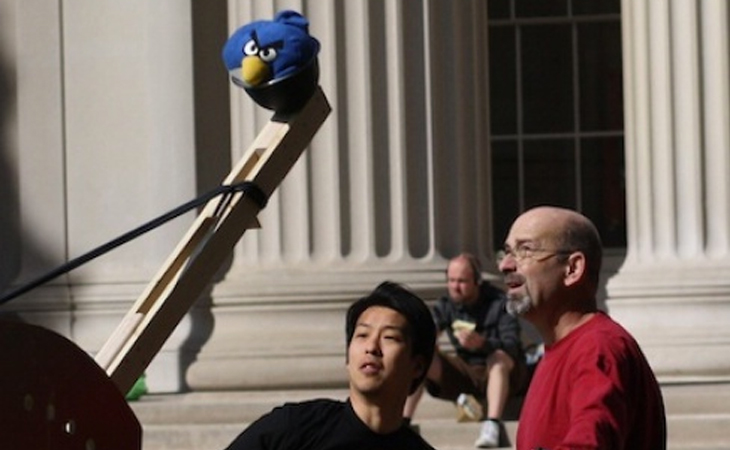Angry Birds Comes to Life on MIT Quad

MIT Course 2.009
(Inside Science) -- Armed with catapults, giant crossbows, and bungee cords, eight teams of senior engineering students brought Angry Birds to life on the main quad of the Massachusetts Institute of Technology, in Cambridge, Mass., last month.
The competition recreated the digital game Angry Birds, an app downloaded more than 500 million times over the past two years. It challenged teams to launch stuffed birds at water-balloon pigs. The first team to knock its pig off a pedestal and retrieve its eggs achieved immortality: its name engraved on a full- size foam replica of hockey's Stanley Cup.
The live-action Angry Birds competition is the brainchild of David Wallace, a mechanical engineering professor who, not surprisingly, grew up in hockey-mad Canada. He teaches students to develop new products by working in teams to rapidly generate ideas and build and test prototypes.
"His class has a reputation for being over the top, crazy, and fun," said Mydia Ruleman, an MIT senior from Memphis. Past competitions have involved death rays, human-powered fire starters, and ways to walk on water.
But if you think the MIT students nailed the Angry Birds competition, you would be wrong. Very wrong.
Wallace designed the project that way. Teams had only 10 minutes to design a device that could hurl a stuffed bird 60 feet. While lab assistants built kits based on those designs, students had only 60 minutes to put them together. It was like soap box derby on steroids.
As a result, great designs and high-performance teams failed in surprising and unusual ways.
Take, for example, the catapult built by Pink Team. "Our machine was so good, it was bad," Jessica Artiles, a senior from Miami, said.
Faced with a complex building project and tight deadline, Artiles' team delegated tasks. Small groups of students worked on each component, such as the base, catapult arm, and the tower that connected the arm to the base.
The problem, Artiles said, was that no one took time to think about how the parts would work together.
"We realized we had no time to adjust the launching mechanism. Professor Wallace had said the target would be 60 feet away, but not how high. To adjust the distance, we had to move the whole machine forward and backwards. It might have weighed 50 pounds," she said.
Nate Fox's team built a ballista, a giant crossbow whose design dates back to ancient Rome. "The good side of using a ballista is that because you are always pulling back the bow to same position, you have a consistent power level. Then you can control the distance by adjusting the angle," the senior from Westport, Conn., said.
Ancient ballistae threw large, rigid spears great distances. His team’s machine could not throw a stuffed bird far enough to reach a pig.
The problem, Fox explained, is that the ballista produced a very fast impulse of energy. When that energy hit a rigid spear, it accelerated it. When it smacked into an angry bird, most of the energy squished the beanbag instead of moving it.
Wallace compared it to kicking a soccer ball. "If it's inflated and hard, you kick it and it goes flying. If it's deflated, it doesn't go far," he said.
The air bazooka should have solved many of the ballista's problems. The design called for students to pressurize a container with a bicycle pump, then open a valve. When the expanding air first rushed into the tube, it would have crumpled the bird. But as it continued to expand, it would have pushed the bird out of the tube with plenty of momentum.
Unfortunately, after a few tests, it began to leak. Team member Ruleman believed this occurred because the valve assembly and bazooka tube did not fit together properly.
"Instead of this really cool high-tech air bazooka, we had two people holding a bungee cord and one person pulling it back to launch birds," she said. "It was really fun, and everyone else wanted to take a turn."
The angry bird spirit was infectious, just like Wallace's past competitions. Last year's contest featured human-powered fire starters. The winner was a plunger that heated air by compressing it.
In 2005, student death rays ignited a 1-inch-thick piece of oak 100 feet away. This showed that the television show, MythBusters, was wrong when it said that ancient Greek scientist Archimedes could not have set ships on fire from a distance.
This year, variations on catapults and slings (including a trebuchet, which combines both concepts) all did well. But that was not the point.
Instead, the aim of the project was to show the difference between theory and practice. "In real-product development, that's why you're testing -- to get insights into what does or does not work and what you want to do next," Wallace said.
Fox agreed. "You can have a really cool idea or theory, but when you build it you might hit obstacles you didn't anticipate."
Alan S. Brown is a long-time freelance writer who has written extensively about science, engineering, technology-related businesses, and technology policy.
